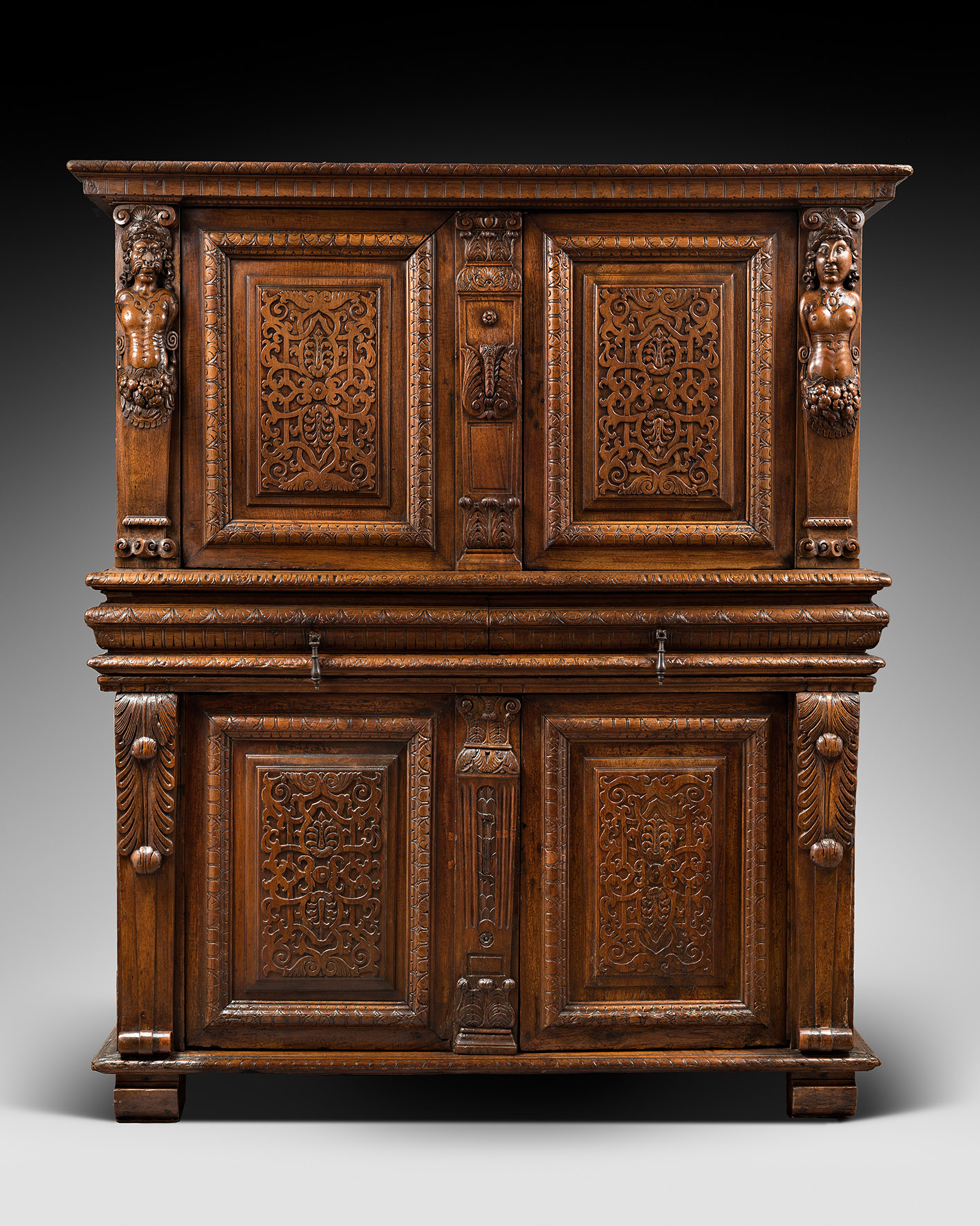Description
In Lyon the 16th century is a time of renewal. The numerous fairs held in the city ensure an economic growth as well as a role of European crossroad where meet diverse influences. In Lyon also sojourns the royal family and artists up to date on current innovations. The flourishing Lyon printing industry allow the most influent and modern artists’ creations to spread. These models are assimilated, reinterprated, transformed in Lyon workshops.
Furthermore, during the Renaissance furniture making adopts Antiquity architectural system inherited via the Quattrocento Italy. In Lyon these solutions are favoured by the presence of Sebastiano Serlio or local architect Philibert de l’Orme back from Rome where he studied antic architecture. Common to all of Europe this reference to Antiquity sets itself apart in Lyon. Indeed, while composition principles and balance rigour are adopted Lyon artists tend to reject architectural elements such as columns or pedimenst. Their work appears harmonious and balanced.
This vogue for Antiquity also invigorate a new ornamental vocabulary where tracery, choux-bourguignons, palm leaves, spokes of heart, putti and grotesques mingle together.
Those are the motifs chosen by cabinet-makers and sculptors to ornate the most luxurious Lyon cabinets. They make use of technical and ornamental processes usually used in metalwork or printing, developing a singular identity.
This cabinet is characterized by its elegant simplicity of lines and the refinement of its decor. Two bodies, identical in dimensions, open with four door-leaves and two drawers located in the belt.
The lower body stands on recessed frontal feet and a base enriched by a twist decor.
Both lateral posts bear a sheath achieved by acanthus leaves while the central one – where the keyhole is located – is ornated with a pilaster standing on an acanthus leaves base centered by a laurel garland and topped by a foliated capital. The door-leaves moulded frame is mitre-cut assembled, adorned by palm leaves carvings. Each panel present a beautiful carved symmetrical tracery decor centred around a choux-bourguignon.
The two drawers belt is animated by the volumes of its profile, enriched by palm leaves decor.
The upper body use the same ternary division. Both door-leaves panels show the same ornamentation while the lateral posts present crowned terms dressed with fruits garlands, male on the left hand side and female on the right hand side. The central post is adorned with foliage, flower, cartouches and a choux-bourguignon hiding the keyhole.
The cabinet is topped by a palm leaves corniche.
The cabinet’s lateral sides present no decor and are only animated by the numerous mouldings evoking the facade’s rhythm.
The rich and meticulous decor, the quality of its making, the refinement of its sculptures reflect the hard work of a skilled cabinet-maker.
This cabinet presents harmonious proportions combined with an architectural structure. The high quality flat-carving decor technic echoes the engraving industry. This very low-relief gives a sumptuous allure to the cabinet by allowing light to play on its surface. Those elements are characteristic of the school of Lyon between 1540-1570.
The conjoint influences of the schools of Burgundy and Lyon are particularly clear with this two-bodies cabinet. This cabinet is evidently linked to the school of Burgundy through master Hugues Sambin. Born around 1518-1520 this carpenter’s son discovered the work of Sebastiano Serlio, Francesco Primaticcio, Francesco Scibec de Carpi and Benvenuto Cellini while working on the château de Fontainebleau site. Head of a prosperous workshop, Hugues Sambin, man of many talents, published in Lyon his « De la Diversité des termes dont on use en architecture, réduit en ordre » in 1572. Using influences from Fontainebleau mannerism and architect Jacques Androuet du Cerceau’s works this compendium assisted many cabinet-makers. Our cabinet’s term sculptures give testimony to the influence of Sambin’s engravings.
With its perfect proportions, purity of lines, rigour of structure and elegance of decor our cabinet is a truly fine example of what the school of Lyon could do best.
Literature
BOCCADOR Jacqueline, Le Mobilier français du Moyen Age à la Renaissance, Éditions d’art Monelle Hayot, 1988
JACQUEMART Jean-Pierre, Hugues Sambin, architecteur, éditions de La Passerelle, Dôle, 2019
JACQUEMART Jean-Pierre, Armoires et cabinets à la fin du la Renaissance en Bourgogne et Franche-Comté
THIRION Jacques, Le Mobilier du Moyen Age et de la Renaissance en France, Edition Faton, 1998
VIRASSAMYNAÏKEN Ludmila (dir.), Arts et Humanisme, Lyon Renaissance, Somogy éditions d’arts, Paris, 2015

